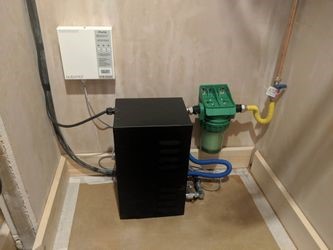6.11.6 Fire Pumps Location, Protection and Automatic Test
The Automist fire pump is a positive displacement pump designed to discharge a constant flow of 6 litres per minute because only one Automist spray head will ever discharge at a fire, as this is electronically controlled. The Assumed Maximum Area of Operation (AMAO) is always a single spray head and therefore the pump only needs to supply the flow and pressure for that one spray head.
It will operate automatically once a fire location and risk has been determined by the controller and will stop operating after 30 minutes (default operation time) or if shut down manually at the controller.
The Automist pump should be:
- located such that it is unlikely to be affected by a fire;
- located where the temperature can be maintained above 4 °C;
- protected electrically by suitable fusing;
- protected against the effects of fire; and
- suitably protected against corrosion
To mitigate overheating when running for long periods, the pump must be installed in one of the following locations with clearance of 100 mm at front and rear:
- In an enclosure (room or cupboard) with volume of at least 0.124m3, that is separated by a fire resisting partition from the mist-protected room(s) that it serves. Alternatively, a flame proof enclosure (G0001_M) can be purchased from Plumis for purpose of protection, to minimise the effect of a fire to the pump when it is in the room it is trying to protect.
- In a cupboard with volume of at least 0.124m3, within a room that the pump serves, with the top of the pump less than 80cm above finished floor level.
Additional clearance at the front and the rear of the pump must also be provided to accommodate the connections.
The Automist pump is not wet pipe and does not need to be churned to maintain reliability. It is a positive displacement pump and locked motor rotors is addressed under the EN60335 standard part 19 'Abnormal Operation'. It is possible to fit a power loss alarm to the system, to alert the user if power is cut. Because the alarm is installed to detect a loss of power, it must be installed on a separate spur of the same circuit as the Automist system.
Automist is also continually monitored through an RS-485 bus connecting every key component and raising a warning if one item is faulty or has been tampered with or removed.
The Automist system does not include a battery back-up as a default and therefore a power loss will not be indicated in the system, it will only be observable by the lack of the green LED on the controller. A local power loss alarm can easily be added to the system if the application demands its use. Alternatively, the power supply can be remotely monitored using third-party hardware.


